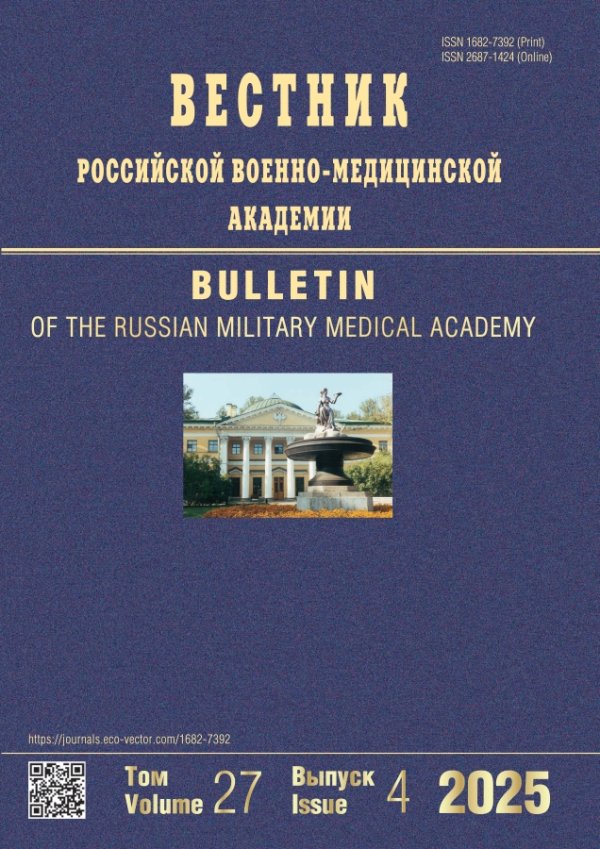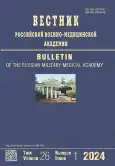方案血液透析患者肠道微生物群组成和微生物源尿毒症毒素含量的变化
- 作者: Pyatchenkov M.O.1, Sherbakov E.V.1, Trandina A.E.1, Glushakov R.I.1, Leonov K.A.2, Kazey V.I.2
-
隶属关系:
- Kirov Military Medical Academy
- Exacte Labs
- 期: 卷 26, 编号 1 (2024)
- 页面: 51-60
- 栏目: Original Study Article
- URL: https://journals.rcsi.science/1682-7392/article/view/255215
- DOI: https://doi.org/10.17816/brmma624008
- ID: 255215
如何引用文章
详细
最近的证据表明,肠道微生物群在慢性肾脏病的发病机制中起着重要作用,尤其是在其晚期阶段。然而,人们对血液透析患者肠道菌群失调的特殊性知之甚少。该研究分析了接受血液透析治疗的终末期肾衰竭患者肠道微生物群变化的特征以及血液中微生物源尿毒症毒素的含量。研究对象包括 80 名接受血液透析方案治疗的患者和 20 名在性别、年龄、体重指数和吸烟状况方面无肾功能障碍的可比人员。使用 Alphalab(俄罗斯)公司生产的商业试剂盒 "Colonoflor 16(高级)",通过聚合酶链式反应对结肠微生物增生状况进行了研究。血清中三甲胺及其代谢物三甲胺-N-氧化物的含量是通过液相色谱法/质谱法进行测定。采用商用试剂盒指令的酶联免疫吸附法评估硫酸吲哚基和硫酸对甲苯基的浓度。在血液透析患者中,肠球菌定植率增加的同时,乳酸菌和双歧杆菌、大肠埃希氏菌、反刍球菌和产生短链脂肪酸的细菌(Faecalibacterium prausnitzii、Eubacterium rectale、Roseburia inulinivorans、Blautia spp.)减少, 并且,还观察到参与维持肠道屏障完整性的微生物(Bacteroides thetaomicron、Akkermansia muciniphila)减少。此外,在这组患者中,还经常发现机会性甚至是致病性菌群代表的滴度增加。方案血液透析患者肠道菌群失调的同时,血液中的尿毒症毒素浓度也显著增加。与肾功能正常的人相比,方案血液透析患者的三甲胺水平升高了22倍,三甲胺-N-氧化物升高了23倍,硫酸吲哚酯升高了21倍,硫酸对甲酚酯升高了5倍。因此,在接受血液透析治疗的人中,肠道微生物生态会发生明显的病理变化,同时血清中微生物源尿毒症毒素的水平也会显著升高。
作者简介
Mikhail O. Pyatchenkov
Kirov Military Medical Academy
编辑信件的主要联系方式.
Email: pyatchenkovMD@yandex.ru
ORCID iD: 0000-0002-5893-3191
SPIN 代码: 5572-8891
MD, Cand. Sci. (Med.)
俄罗斯联邦, Saint PetersburgEvgeniy V. Sherbakov
Kirov Military Medical Academy
Email: evgenvmeda@mail.ru
ORCID iD: 0000-0002-3045-1721
SPIN 代码: 6337-6039
俄罗斯联邦, Saint Petersburg
Alexandra E. Trandina
Kirov Military Medical Academy
Email: sasha-trandina@rambler.ru
ORCID iD: 0000-0003-1875-1059
SPIN 代码: 6089-3495
俄罗斯联邦, Saint Petersburg
Ruslan I. Glushakov
Kirov Military Medical Academy
Email: glushakoffruslan@yandex.ru
ORCID iD: 0000-0002-0161-5977
SPIN 代码: 6860-8990
MD, Dr. Sci. (Med.)
俄罗斯联邦, Saint PetersburgKlim A. Leonov
Exacte Labs
Email: pyatchenkovMD@yandex.ru
ORCID iD: 0000-0003-4268-1724
MD, Cand. Sci. (Chem.)
俄罗斯联邦, MoscowVasily I. Kazey
Exacte Labs
Email: pyatchenkovMD@yandex.ru
ORCID iD: 0000-0003-2032-6289
SPIN 代码: 6253-0211
MD, Cand. Sci. (Biol.)
俄罗斯联邦, Moscow参考
- Mishima E, Abe T. Gut microbiota dynamics and uremic toxins. Toxins (Basel). 2022;14(2):146. doi: 10.3390/toxins14020146
- Tkachenko EI, Grinevich VB, Gubonina IV, et al. Disease as a result of violations of the symbiotic relationship between the host and the microbiota with pathogens. Bulletin of the Russian Military Medical Academy. 2021;23(2):243–252. EDN: OIYFED doi: 10.17816/brmma58117
- Pyatchenkov MO, Vlasov AA, Sherbakov EV, et al. Features of assessing the intestinal barrier permeability in chronic kidney disease. Experimental and clinical gastroenterology journal. 2022;(11):46–59. EDN: BLYDXK doi: 10.31146/1682-8658-ecg-207-11-46-59
- Pyatchenkov MO, Salikova SP, Sherbakov EV, Vlasov AA. The state of the intestinal microbial-tissue complex in patients with chronic kidney disease. Bulletin of the Russian Military Medical Academy. 2023;25(1):155–164. EDN: RBHWNK doi: 10.17816/brmma124822
- Wong J, Piceno YM, DeSantis TZ, et al. Expansion of urease- and uricase-containing, indole- and p-cresol-forming and contraction of short-chain fatty acid-producing intestinal microbiota in ESRD. Am J Nephrol. 2014;39(3):230–237. doi: 10.1159/000360010
- Voroneanu L, Burlacu A, Brinza C, et al. Gut microbiota in chronic kidney disease: from composition to modulation towards better outcomes-A systematic review. J Clin Med. 2023;12(5):1948. doi: 10.3390/jcm12051948
- Vaziri ND, Zhao Y-Y, Pahl M. Altered intestinal microbial flora and impaired epithelial barrier structure and function in CKD: the nature, mechanisms, consequences and potential treatment. Nephrol Dial Transplant. 2016;31(5):737–746. doi: 10.1093/ndt/gfv095
- Sturov NV, Popov SV, Belikov II. Gut microbiota and the ways to correct it in chronic kidney disease. Indian J Nephrol. 2023;33(3): 162–169. doi: 10.4103/ijn.ijn_469_21
- Kornoukhova LA, Emanuel VL, Denisov NL. Routine methods of laboratory studies of intestinal microbiota: role and place in clinical practice. Russian journal of evidence-based gastroenterology. 2021;10(4):5–11. EDN: YKMKPG doi: 10.17116/dokgastro2021100415
- Vaziri ND, Wong J, Pahl M, et al. Chronic kidney disease alters intestinal microbial flora. Kidney Int. 2013;83(2):308–315. doi: 10.1038/ki.2012.345
- Wehedy E, Shatat IF, Al Khodor S. The human microbiome in chronic kidney disease: a double-edged sword. Front Med (Lausanne). 2022;8:790783. doi: 10.3389/fmed.2021.790783
- Zhao J, Ning X, Liu B, et al. Specific alterations in gut microbiota in patients with chronic kidney disease: an updated systematic review. Ren Fail. 2021;43(1):102–112. doi: 10.1080/0886022X.2020.1864404
- Bhargava S, Merckelbach E, Noels H, et al. Homeostasis in the gut microbiota in chronic kidney disease. Toxins (Basel). 2022;14(10):648. doi: 10.3390/toxins14100648
- Hänninen A, Toivonen R, Pöysti S, et al. Akkermansia muciniphila induces gut microbiota remodelling and controls islet autoimmunity in NOD mice. Gut. 2018;67(8):1445–1453. doi: 10.1136/gutjnl-2017-314508
- Tamanai-Shacoori Z, Smida I, Bousarghin L, et al. Roseburia spp.: a marker of health? Future Microbiol. 2017;12:157–170. doi: 10.2217/fmb-2016-0130
- Hu Q, Wu K, Pan W, et al. Intestinal flora alterations in patients with early chronic kidney disease: a case-control study among the Han population in southwestern China. J Int Med Res. 2020;48(6): 1–12. doi: 10.1177/0300060520926033
- Henke MT, Kenny DJ, Cassilly CD, et al. Ruminococcus gnavus, a member of the human gut microbiome associated with Crohn’s disease, produces an inflammatory polysaccharide. PNAS USA. 2019;116(26):12672–12677. doi: 10.1073/pnas.1904099116
- Belova IV, Khrulev AE, Tochilina AG, et al. Colon microbiocenosis and its correction in patients receiving programmed hemodialysis. Modern technologies in medicine. 2020;12(5):62–70. EDN: ZPWVRM doi: 10.17691/stm2020.12.5.07
- Noce A, Marchetti M, Marrone G, et al. Link between gut microbiota dysbiosis and chronic kidney disease. Eur Rev Med Pharmacol Sci. 2022;26(6):2057–2074. doi: 10.26355/eurrev_202203_28354
- Pyatchenkov MO, Vlasov AA, Sherbakov EV, Salikova SP. Microbial-derived uremic toxins: role in the pathogenesis of comorbidities in patients with chronic kidney disease. Russian Journal of Gastroenterology, Hepatology, Coloproctology. 2023;33(3):7–15. EDN: DZGPXN doi: 10.22416/1382-4376-2023-33-3-7-15
- Kryukov EV, Potekhin NP, Chaplyuk AL, et al. Expert approaches to chronic kidney disease. Military medical journal. 2016;337(10): 13–18. EDN: XBTEMF doi: 10.17816/RMMJ73839
补充文件








